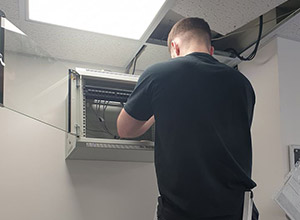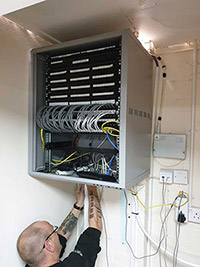Structured Cabling

What is a structured cabling system?
A structured cabling solution refers to a standardised way of designing and installing a network's cabling infrastructure. This includes the use of specific cable types, connectors, and installation practices that are designed to provide a reliable and efficient data transfer. A structured cabling system includes everything from the data outlets in the walls to the patch panels, switches and servers in the data center. The goal is to provide a flexible and scalable infrastructure that can support current and future network technologies and protocols.
Design and Planing
Using the right cabling types and connectors is important for any structured cabling solution because it ensures that the network will be able to transfer data at the highest possible speeds and with the least amount of errors. Different cabling types, such as copper and fiber optic, have different characteristics that make them better suited for specific applications. For example, copper cables are typically less expensive and easier to work with than fiber optic cables, but they have a shorter maximum distance and lower bandwidth capacity. Fiber optic cables, on the other hand, are more expensive and more difficult to work with, but they have a much longer maximum distance and higher bandwidth capacity. The right connectors are important because they ensure a secure and reliable connection between the cable and the network components.
Using the right cabling types and connectors that meet industry standards and regulations, such as TIA/EIA, ensures that the network will be compatible with other networks and devices, and that it will be able to support future technologies and protocols. It also allows for easier troubleshooting and maintenance of the network, it can save time and money in the long run.
Installation
Correct installation of a structured cabling solution is important because it ensures that the network will function properly and provide optimal performance. Incorrect installation can lead to a variety of problems, such as signal loss, data errors, and connectivity issues. These problems can result in decreased productivity, lost revenue, and increased maintenance costs. Additionally, if the cabling infrastructure is not installed correctly, it may not be able to support future network upgrades or new technologies. A properly installed structured cabling solution will provide a stable and reliable network that can support current and future business needs.
Whether you have a new construction project that needs to be fully cabled, existing building or office that only needs a few additional data drops, Sheridan's can provide you with all your structured cabling and wiring needs.
Have a structured cabling project?
Get in touch to discuss how we can help!
Upgrades and Modifications
Structured cabling systems can be upgraded and extended to accommodate the growing needs of a business and to support new technologies and protocols. Here are a few ways that a structured cabling system can be upgraded or extended:
- Upgrading cable types: One way to upgrade a structured cabling system is to replace older cable types with newer ones that offer higher bandwidth and faster speeds. For example, replacing copper cables with fiber optic cables can increase the maximum distance and bandwidth capacity of the network.
- Adding new outlets: Another way to extend a structured cabling system is to add new data outlets in areas where they are needed. This can be done by running new cables from existing patch panels and switches to the new outlets.
- Upgrading patch panels and switches: Upgrading patch panels and switches can increase the number of ports available on the network, which allows for more devices to be connected. This can also increase the speed and bandwidth capacity of the network.
- Adding new racks and cabinets: As a business grows and more equipment is added, additional racks and cabinets may be required to accommodate the additional equipment.
- Upgrading to higher speed network protocols: As new technologies and protocols become available, it may be necessary to upgrade the network to support them. This can include upgrading to faster Ethernet standards or installing new software and firmware on network devices.
It's important to note that upgrading and extending a structured cabling system should be done by professionals who are trained and experienced in cabling installation and best practices. This ensures that the network will continue to function properly and provide optimal performance.
Cleanups and Labelling

Cable management and tidiness are important aspects of a structured cabling system, as it ensures that the network will function properly and provide optimal performance. Poor cable management can lead to a variety of problems, such as signal loss, data errors, and connectivity issues. Additionally, a poorly managed and untidy cabling infrastructure can make it difficult to troubleshoot and maintain the network, which can result in increased downtime and maintenance costs.
Proper cable management involves organising and labeling cables in a way that makes it easy to identify and access them. This can include using cable ties and routing them in an orderly manner. This helps to keep the cables away from potential sources of interference, such as fluorescent lights and machinery, and reduce the risk of damage. Furthermore, labeling cables properly makes it much easier to identify which cable goes where, and to trace cables when troubleshooting.
If your comms room could do with a little love then please get in touch via our contact form, we will get back to you to arrange a visit and provide you with a quotation to spruce things up a little.

